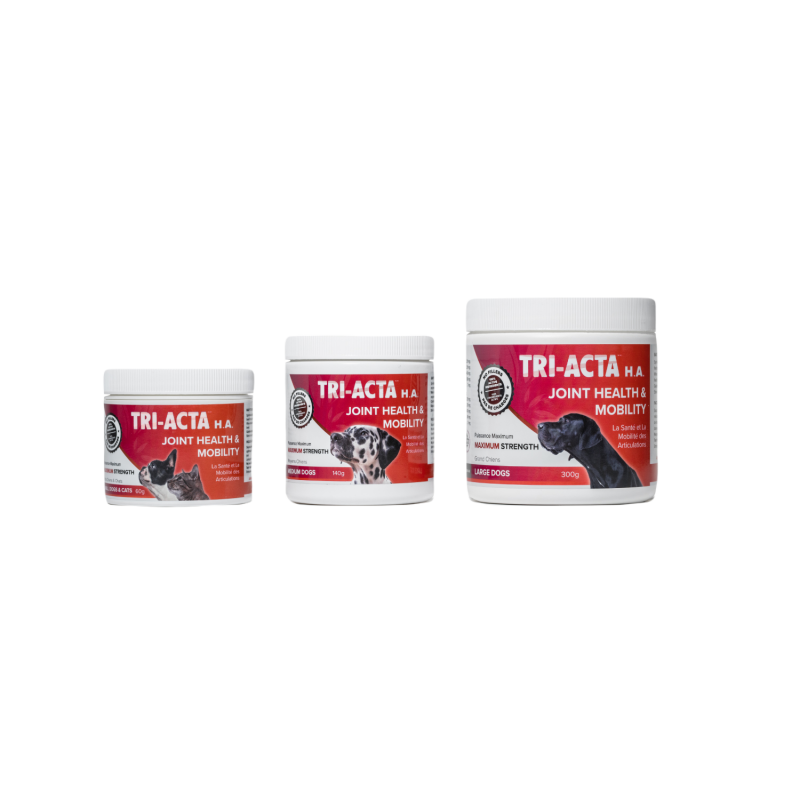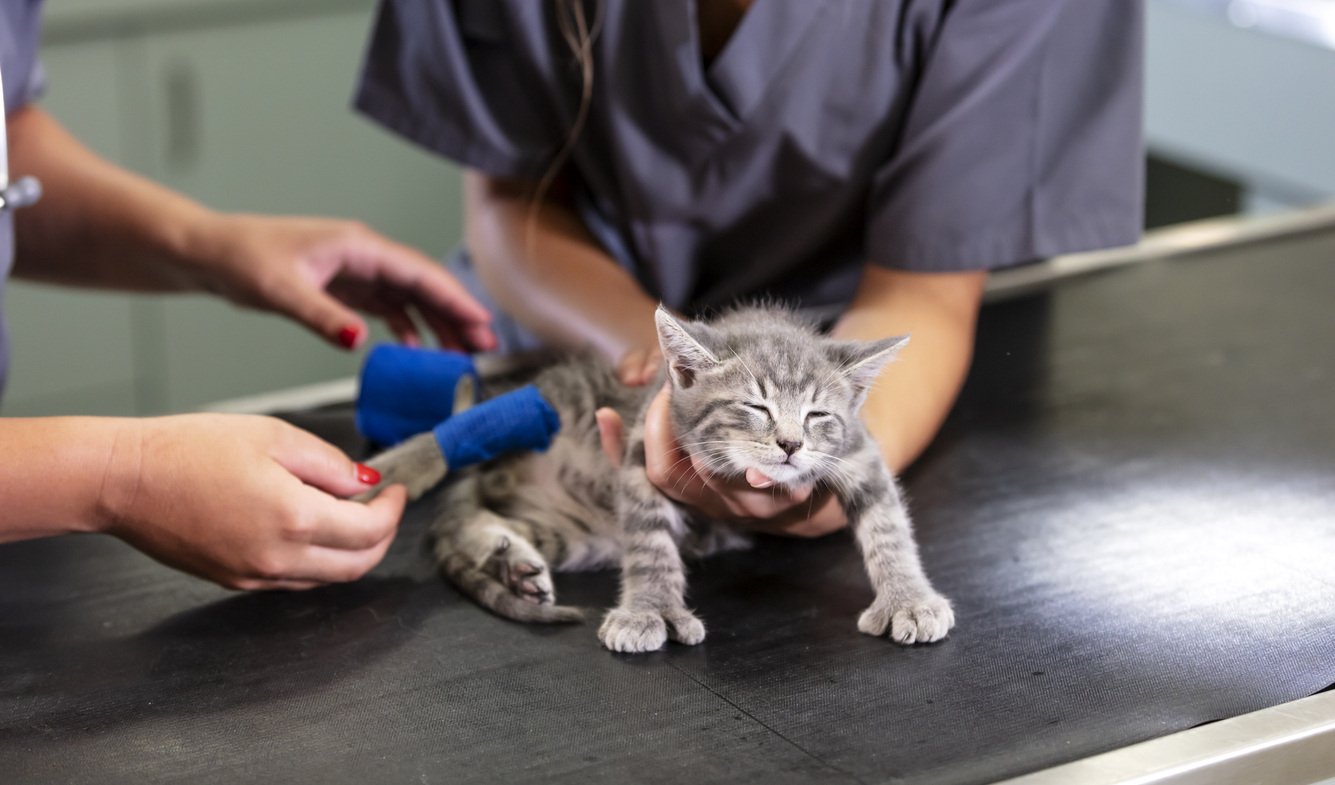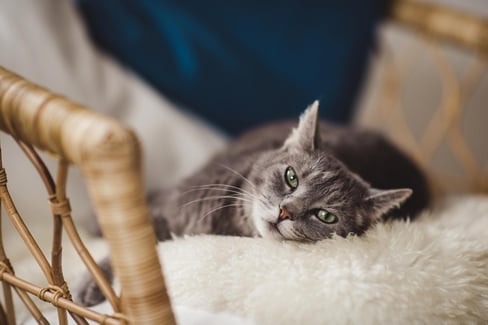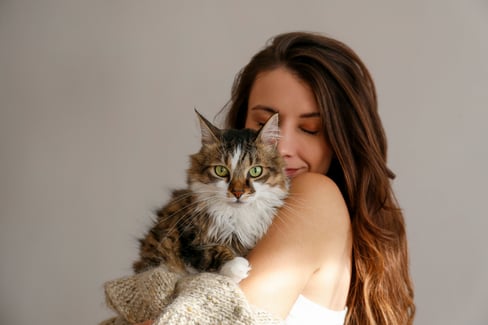Table of Contents
Cats are naturally curious and adventurous, but sometimes, this inquisitiveness can land them in a pickle. It could be that they got in an altercation with another animal, injured themselves while squeezing through a tight spot, or received a puncture wound from a foreign object such as:
- Glass
- Sticks
- Thorns
While most common cat wounds don't require treatment and can heal on their own, a few others may require more intensive care.
This cat wound care guide is your saving grace in helping you identify different types of feline injuries and treating them so your furry companion can get back to good health in no time.
Common Cat Wounds
The various types of cat wounds present unique challenges in treating and managing them. Everything from superficial scratches to deep punctures, cuts, and abrasions must be cared for correctly, especially if you have a senior cat.
Here's a list of the most common cat wounds.
Puncture Wounds
This is where the importance of knowing how to care for an open wound on a cat comes into play.
A puncture wound can occur in numerous ways, whether through scratches, animal bites, or sharp objects. The downside to puncture wounds is that they can often cause contusions to underlying tissues, especially if your feline friend has been bitten by another animal.
Taking your pet to a veterinarian is highly recommended if you find a puncture wound that is:
- Bruised
- Swollen
- Painful
- Draining pus
- Bleeding
Depending on the damage, your veterinarian may need to sedate your feline to administer the appropriate wound care for cats. Getting your pet to the vet within 24 hours of discovering the injury is best so it doesn't progress to something worse.
Bite Wounds
Abrasions or bite marks are telltale signs that your pet was bitten by another animal. If you notice your cat was bitten, you must get them to the vet immediately.
They can administer thorough cat wound care by:
- Inspecting the wound
- Flushing it out
- Determining if it requires stitches
If your pet has received a bite wound, get them to the vet immediately, as they'll know exactly how to care for a cat's wound.
Moreover, the animal who bit your cat may not be up to date with their rabies vaccine, which could lead to further complications down the line. Depending on your province or state, there may be a recommended rabies quarantine time to keep you and your pet safe and sound.
Minor Cuts and Abrasions
Superficial injuries are common occurrences and often don't require intensive cat wound care. With little to no treatment, minor cuts and abrasions can heal independently.
Just make sure your cat is not constantly licking the wound and there is no:
- Pain
- Odor
- Pus
- Bleeding
- Swelling
Be cautious with fur around these types of wounds, as it can make it challenging to see how bad the damage is. If you feel uncertain about the extent of the damage, it's recommended that you carefully trim the hair around the cut or abrasion to assess the wound properly.
Abscesses
Puncture wounds are often the root cause of abscesses. They typically occur when the skin closes over the wound, and bacteria is still under it. Surrounding tissue can start out flat and cause inflammation, making your furry friend feverish, lethargic, and hurt.
Abscesses can swell and become warm, excruciatingly sore pockets of liquid that can shift around under the skin. If left untreated, abscesses can make your pet extremely sick and cause fevers in cats that often require a visit to a veterinarian.
Keep a close eye on your cat if you notice any swelling under the skin, bleeding or draining from wounds, or a fresh puncture. If these symptoms correlate with your animal not wanting to move around, not eating, or being extremely lethargic, immediately get them to the nearest vet.
Blisters or Sores
The eosinophilic granuloma complex is an inveterate issue that originates from skin wounds. It typically causes reddened, raised skin and, at worst, skin cancer. These blisters or sores normally materialize as smaller lesions or masses that puff up as they grow.
If you notice any abnormal masses on your pet, it's critical that you book an appointment with your veterinarian for further examination. Your veterinarian may take a few samples via cytology or fine needle aspiration to determine a direct prognosis and course of action.
Importance of Knowing Basic Cat Wound Care
As a responsible feline parent, it's crucial you arm yourself with knowledge of rudimentary cat wound care. Besides meeting your cat's basic needs, knowing how to handle injuries is key to ensuring your cat's happiness and health.
Whether it's a serious wound or a minor scratch, evaluating and treating injuries promptly aids in swift healing while reducing complications. Understanding the nature of the wound and the corresponding cat wound care steps enables you to respond appropriately to your feline friend's injuries to facilitate a speedy recovery.
Let's examine some typical cat wounds and basic care guidelines (we'll discuss them in more detail later.)
|
Wound Type |
Description |
Basic Care Guidelines |
|
Abrasions |
Superficial scrapes on the skin surface |
Clean with a mild antiseptic solution, apply antibiotic ointment, and cover with a non-adherent dressing |
|
Lacerations |
Jagged, irregular cuts that penetrate the skin |
Gently clean with saline solution, control bleeding, and seek veterinary attention if deep or extensive |
|
Puncture Wounds |
Small, deep injuries caused by sharp objects |
Clean with antiseptic solution, monitor for signs of infection, and consult a vet for possible antibiotics |
|
Bite Wounds |
Injuries resulting from fights or encounters with animals |
Thoroughly clean to remove bacteria, apply antibiotic ointment, and seek veterinary evaluation |
|
Abscesses |
Pockets of pus formed from infected wounds |
Drainage may be necessary under veterinary supervision, follow-up with wound care and antibiotics |
Mastering primary cat wound care and understanding when to seek veterinary attention are essential aspects of responsible pet ownership. By familiarizing yourself with the common types of cat wounds and their appropriate care protocols, you can effectively address injuries and promote your pet's health and comfort.
Remember, early intervention and proper wound management play a significant role in ensuring the well-being and longevity of our beloved feline companions.
How to Care for a Wound on a Cat
Now that you understand the importance of knowing the basics of cat wound care, we'll show you how to assist your furry companion in their time of need. Due to the variety of injuries your cat can experience, tackling each scenario requires a nuanced approach that fits the particular injury they've sustained.
Cat Paw Wound Care / Cat Cut Paw
Cat's paws are the epicenter of their life, and rightfully so. Without them, your feline friend will be incapable of even the most basic things. Hence, treating a cat's cut paw is of the utmost
importance.
Follow the steps below to help with a simple cat paw injury:
- If your cat is bleeding, apply gentle pressure with a clean cloth or gauze to stanch the bleeding.
- Once the bleeding subsides, gently clean the area with a saline solution or mild antiseptic.
- To avoid infection, apply an antibiotic cream after disinfecting the wound.
- Contact a vet if the cut is causing your pet discomfort or appears to be deep.
- Utilize an Elizabethian collar or other protective device to prevent licking that'll cause a swollen cat paw (something you don't want to experience after tending to your feline over an extended period.)
Before using over-the-counter medicine, remember that your feline friend may react to certain drugs. If you are uncertain about your pet's anaphylaxis response to specific medication, it's best to consult your veterinarian.
Cat Puncture Wound Care
Though often small and seemingly nugatory, cat puncture wounds can pose serious feline health risks if ignored. They are typically caused by sharp objects, such as teeth, nails, and other foreign bodies, penetrating the skin.
Irrespective of their size, puncture wounds can result in deep tissue damage and provide an ideal environment for bacteria and infection to thrive. Prompt and proper cat wound care is essential to prevent further harm and promote a fast, optimal healing process
Follow the guidelines below:
- Assess the wound and remove debris, bacteria, or foreign material.
- Use an antiseptic or saline solution to irrigate the wound gently.
- Avoid hydrogen peroxide, harsh chemicals, or alcohol, as they irritate the tissue.
- Pat the area down with a clean cloth or gauze after sterilizing.
- Apply an antibiotic to prevent infection.
- If there are no improvements within a few days, seek veterinary attention promptly
To avoid future puncture wounds, take precautions to minimize potential hazards in your pet's environment, such as aggressive animals or sharp objects. Ensure your cat's vaccinations are up-to-date, as puncture wounds from other animals can increase the risk of certain infections.
Cat Ear Wound Care
To promote healing and prevent attention, ear damage to your feline friend requires prompt attention and proper treatment.
Here are some important steps to follow:
- Gently administer cat wound care by cleansing the wound with a saline solution or antiseptic wash recommended by your veterinarian, removing excess discharge, debris, and dirt during the process.
- Apply an antibiotic cream or ointment specifically formulated for animals, as advised by your vet.
- Use a non-stick bandage or dressing to protect the wound from further irritations or contamination.
- Keep an eye on the wound for signs of infection, such as fever, discharge, redness, or increased swelling.
- Keep the area around the wound clean and dry by gently wiping it with a clean, damp cloth or using an ear cleaner specifically designed for cats.
- Give your cat pain relievers or antibiotics as directed by your veterinarian.
- Ensure your furry companion doesn't lick or scratch the wound, as this can introduce infection.
If after cat wound care is administered on your feline friend's ear and the damage appears severe, deep, or does not show signs of improvement within a few days, contact your veterinarian for professional advice and treatment.
Cat Fight Wound Care
Probably one of the worst ways a cat can receive an injury is through a fight. Once you've discovered that your cat has been in a fight and there is clear evidence of damage, deciding how to care for it becomes imperative.
Begin cleaning the area with warm, salty water or a veterinary wound wash appropriately diluted. The bonus of using salt water is that it won't affect your cat negatively if they lick the area after you've cleaned it.
Next, clean the wound's surface with cotton wool pads to remove any material or dried blood from the cut or puncture. Throw away each pad after wiping it to avoid adding bacteria back into the solution. Cat wound care spray can be used, but we recommend spraying it on cotton instead of directly on their injury.
If you notice the puncture or cut developing into a cat bite abscess or is more painful than when it first appeared, you must get your feline friend examined by your veterinarian immediately.
What Ointment Can I Put On a Cat Wound?
A comprehensive approach is often required to ensure proper healing and avoid complications when performing cat wound care. The type of medication and treatment plan will depend on various factors, including the location, severity, and cause of the wound, as well as the cat's overall health.
Check out this table of common medications and treatments utilized for cat wound care:
|
Medication/Treatment |
Purpose |
Considerations |
|
Antibiotic Ointments/Creams (e.g., Triple Antibiotic Ointment, Bacitracin) |
Applied topically to prevent infection and promote healing |
Suitable for minor, superficial wounds |
|
Oral Antibiotics (e.g., Amoxicillin, Clavamox) |
Combat bacterial infections associated with the wound |
Prescribed based on the type and severity of infection |
|
Pain Relievers (e.g., Metacam, Buprenorphine) |
Manage pain and discomfort caused by the wound |
Dosage and duration depend on the level of pain and the cat's response |
|
Anti-inflammatory Medications (e.g., Prednisolone) |
Reduce inflammation and swelling around the wound area |
May be prescribed for moderate to severe wounds or in cases of prolonged healing |
|
Wound Flushing |
Cleaning and removing debris from the wound |
Sterile saline solution or antiseptic solution recommended by the vet |
|
Bandaging |
Protecting the wound from further contamination and trauma |
Proper bandaging techniques are crucial to prevent constriction or irritation |
|
Surgical Intervention |
Closing deep or complex wounds |
May involve suturing, debridement, or other procedures |
|
Laser Therapy |
Promoting faster healing and reducing inflammation |
Often used in conjunction with other treatments |
It's important to note that self-medicating or applying over-the-counter products without veterinary guidance can be detrimental and risky to your feline companion's healing process. Always consult a licensed veterinarian before administering any treatment or medication to your cat.
Additional Products for Cat Wound Care at Home
As we know, cat wound care can be a delicate task, requiring proper medical treatment and the most appropriate products to assist in the healing process. While veterinary guidance should always be the primary source of information, having the correct cat wound care products at home can make the process smoother and more effective.
Here are some additional products that can be helpful for cat wound care at home.
|
Topical Treatments, Bandaging, and Protective Gear |
Purpose |
Considerations |
|
Antiseptic Wound Sprays for Cat |
Clean and disinfect the wound area before applying other topical treatments |
Examples include chlorhexidine solution, Vetericyn, or Vetric |
|
Saline Solution |
Flush and clean wounds, removing debris and promoting healing |
Sterile saline solution or preservative-free contact lens solution can be used |
|
Wound Flush Solution |
Flush and cleanse wounds, removing dirt, debris, and bacteria |
Products like SkinMate Antiseptic Solution or Vetericyn Wound Flush |
|
Antibacterial Ointments |
Prevent infection and promote healing in minor wounds |
Consult with your veterinarian before use |
|
Hydrogel Dressings |
Keep wounds moist to aid in the healing process |
Particularly useful for dry or scabbed wounds |
|
Antimicrobial Barrier Creams |
Create a protective barrier over the wound, preventing bacterial contamination |
Examples include Balmex or Critic-Aid Clear |
|
Non-Adherent Dressings |
Protect the wound without sticking to it, making removal easier and reducing the risk of further injury |
Examples include Telfa or N-A Pads |
|
Adhesive Bandages |
Cover and protect smaller cuts or abrasions, preventing further contamination and keeping the area clean |
May not be suitable for larger wounds |
|
Elizabethan Collars |
Prevent licking or scratching of the wound, which can delay healing and introduce infection |
Choose a comfortable and well-fitting collar |
Although these products can be helpful in managing minor cat wound care at home, it's always recommended that you consult with your vet before using any new product on your cat. Your qualified vet can advise on the most appropriate products for your feline's specific situation while ensuring their safety.
Complications for Improper Cat Wound Care
Competent cat wound care ensures a smooth and efficient healing process. Improperly treating or neglecting to treat an injury can lead to various complications, some of which can be severe to potentially life-threatening.
The best thing you can do is arm yourself with the knowledge of potential complications and seek prompt veterinary care when necessary.
Let's look at some common complications that can arise from improper cat wound care:
- Infection: A significant risk of improper cat wound care is the development of an infection or septicemia. Injuries not adequately cleaned and disinfected can turn into a breeding ground for bacteria, leading to systemic or localized infections. Signs of infections may include lethargy, fever, pus or discharge, redness, and swelling. The last thing you want for your furry companion is an infection that spreads, becomes challenging to manage, and potentially leads to sepsis.
- Delayed healing: Inappropriate cat wound care, such as incorrect bandaging, lack of moisture, or improper cleaning, can massively reduce healing time. A prolonged healing process increases the risk of infection, putting your cat in greater discomfort and possibly leading to scarring or other complications.
- Excessive scarring: While some scarring is inevitable with wound healing, excessive or abnormal scarring may occur if the wound is not treated properly. Functional impairments, potential mobility issues, and unsightly scars can materialize depending on the location of the injury.
- Seroma formation: This complication often presents itself as a pocket of fluid that builds up under the skin. Seromas occur if a wound is not drained properly or if there is excessive trauma or movement to the area during the healing process.
- Wound dehiscence: The reopening of a wound that has fully or partially healed, otherwise known as wound dehiscence, typically occurs if improper cat wound care is not administered. It can also happen if your pet engages in excessive activity or experiences additional trauma in the area. Both the healing process and risk of infection are extended by wound dehiscence.
- Chronic pain or discomfort: Indecorous cat wound care or inadequate pain management can lead to discomfort or chronic pain for your cat. It will negatively impact your feline companion's quality of life, potentially leading to other health problems or behavioral issues, such as lashing out when you want to rub them or periodontal disease.
- Systemic complications: In severe cases, poor cat wound care can lead to systemic complications, such as serious health issues, organ failures, or sepsis. This is particularly prevalent in cats with a compromised immune system or ones with underlying medical conditions.
To avoid these potential complications, please follow your veterinarian's instructions carefully and seek professional medical assistance if you notice any signs of concern, such as discharge, redness, or excessive swelling. Also, if the wound is not healing as expected, you should contact your vet immediately after noticing its progress.
When in doubt, consult your veterinarian for proper guidance and treatment protocols. Appropriate and prompt cat wound care significantly reduces the risk of complications while ensuring a smoother recovery for your feline companion.
Cat Wound Care—Final Thoughts
Proper wound care for your feline companion promotes healing, prevents complications, and ensures their overall well-being. While minor wounds may seem manageable at home, seeking professional veterinary guidance is crucial to ensure appropriate treatment and avoid potential complications.
Remember, improper cat wound care can lead to various issues, including infections, delayed healing, excessive scarring, seroma formation, wound dehiscence, chronic pain, and even systemic complications in severe cases. It's always better to err on the side of caution and consult with your veterinarian whenever you have doubts or concerns about your cat's wound.
By following your veterinarian's instructions carefully, using appropriate wound care products, and providing proper wound management, you can support your cat's healing process and help prevent further complications. Regular monitoring and prompt action at the first signs of concern can significantly affect your cat's recovery.
Sometimes cat wounds can affect other structures in their body—namely their joints if they get a wound on a limb. The cat compensating for a leg injury by putting increased pressure on another, healthy leg is one example. This added joint pressure can result in faster joint degradation or aggravate existing joint conditions. One of the ways you can help ensure that your cat has the joint support they need while healing is to incorporate the right cat supplements into their diet. TRI-ACTA H.A. is a good choice because the addition of hyaluronic acid provides enhanced lubrication to support their joints while they heal.
TRI-ACTA H.A. for Pets
Our maximum strength formula is optimally designed to accelerate the formation of cartilage, minimize inflammation, expedite the healing process, and improve joint conditions.

Purchase TRI-ACTA online or learn where to buy at a store near you.
Newsletter Signup
Subscribe to our newsletter to receive the latest news and exclusive offers.
.jpg?height=2000&name=Cliick_Integricare-DISPLAY-REVISEDV2%20(1).jpg)
Proactive & Therapeutic Joint Supplements
When given daily, Integricare joint supplements recover bone and joint injuries faster and help prevent mobility injuries from happening in the first place.











